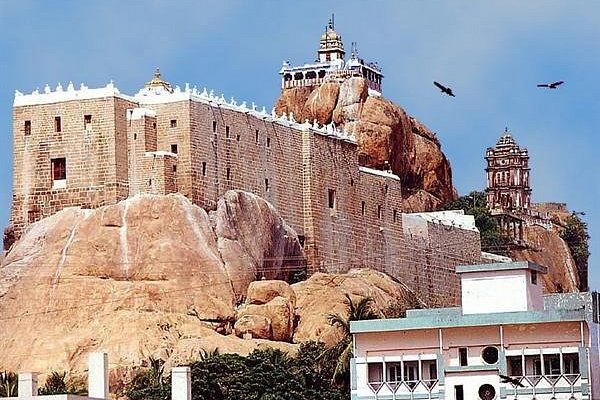Tiruchirapalli, commonly known as Trichy, is a city steeped in history and culture. Nestled along the banks of the Cauvery River in Tamil Nadu, it is a place where ancient traditions meet modern progress. For history enthusiasts, Trichy offers a treasure trove of forts, temples, and landmarks that narrate tales of its illustrious past. Here’s a guide to exploring Trichy’s historical trails.
1. The Iconic Rockfort: A Symbol of Trichy
Rising majestically above the city skyline, the Rockfort is Trichy’s most recognizable landmark. This massive rock, believed to be over 3.8 billion years old, is home to two important temples – the Ucchi Pillayar Temple dedicated to Lord Ganesha and the Thayumanaswami Temple dedicated to Lord Shiva.
Highlights:
Climb 437 Steps: Carved into the rock, these steps lead to panoramic views of Trichy.
Historic Significance: The fort has witnessed battles and served as a strategic defense point during the Vijayanagara Empire and later the Carnatic wars.
Architectural Marvel: The temples on the rock showcase intricate Dravidian craftsmanship.
2. Srirangam: The Spiritual Island
Situated on an island between the Cauvery and Kollidam rivers, Srirangam is home to the sprawling Sri Ranganathaswamy Temple. This temple, dedicated to Lord Vishnu, is one of the largest functioning temple complexes in the world and a prime example of Dravidian architecture.
Highlights:
Gopurams: The temple boasts 21 colorful towers, with the Rajagopuram standing at 236 feet, making it the tallest temple tower in Asia.
Sacred Atmosphere: Witness rituals, festivals, and the spiritual fervor that fills the temple complex.
Historical Roots: The temple’s origins date back to the Chola dynasty, with significant contributions from the Vijayanagara and Nayak rulers.
3. Jambukeswarar Temple: A Celebration of Water
Located near Srirangam, the Jambukeswarar Temple is dedicated to Lord Shiva in the form of water (Appu Lingam). It is one of the five Pancha Bhoota Sthalas, each representing an element of nature.
Highlights:
Unique Worship: Priests perform rituals dressed as female devotees, symbolizing devotion to Lord Shiva.
Architectural Splendor: Massive pillars, carved mandapams, and sacred tanks adorn the temple.
Mythological Significance: According to legend, the temple was built by an elephant and a spider as an offering to Lord Shiva.
4. Tiruchirapalli Fort: A Legacy of Battles
While much of the original Tiruchirapalli Fort has disappeared, its remnants speak volumes about Trichy’s martial history. The fort played a pivotal role during the Carnatic Wars and has links to the British and French colonial forces.
Highlights:
Architectural Remains: Explore old walls, gates, and trenches that whisper stories of warfare.
St. John’s Church: Within the fort complex, this church built by the British in 1812 is a reminder of Trichy’s colonial past.
Fortified History: Learn about how the fort served as a seat of power for the Nayak dynasty and later the British.
5. The Cauvery River: Lifeblood of Trichy
The Cauvery River is not just a geographical feature but a vital part of Trichy’s history and culture. It has sustained the region for centuries and serves as a focal point for many historical landmarks.
Highlights:
Kallanai Dam: Built by the Chola king Karikalan over 2,000 years ago, this ancient structure is a testament to the engineering prowess of ancient India.
Rituals and Festivals: Witness locals performing traditional rituals along the riverbanks.
6. Government Museum: A Walk Through History
The Government Museum in Trichy offers an immersive experience into the city’s history. From ancient artifacts to colonial relics, the museum is a must-visit for history buffs.
Highlights:
Bronze Statues: Admire intricate bronze sculptures from the Chola period.
Stone Inscriptions: Learn about the region’s history through ancient Tamil inscriptions.
Colonial Exhibits: Explore artifacts from the British era.
7. Uraiyur: The Ancient Capital
Before Trichy, Uraiyur was the seat of the early Chola dynasty. Today, it is a quiet neighborhood but holds historical significance as one of Tamil Nadu’s oldest cities.
Highlights:
Vekkali Amman Temple: Dedicated to Goddess Vekkali Amman, this temple has no roof, symbolizing the open sky.
Archaeological Significance: Unearthed relics here provide glimpses into the ancient Chola civilization.
8. Grand Anaicut Canal: A Chola Engineering Marvel
Stretching across the landscape, the Grand Anaicut Canal is an ancient irrigation system that reflects the Cholas’ mastery of water management.
Highlights:
Agricultural Importance: This canal transformed the Cauvery Delta into one of the most fertile regions in India.
Historical Value: It showcases the strategic and innovative governance of the Chola rulers.
9. Cultural Insights Through Festivals
Trichy’s historical richness is best experienced during its vibrant festivals. Events like Vaikunta Ekadasi at Srirangam and Panguni Uthiram at the Rockfort temples bring history alive with processions, rituals, and traditional music.
Highlights:
Devotional Atmosphere: Temples are adorned with lights and flowers, creating a magical setting.
Traditional Art Forms: Witness classical music, Bharatanatyam, and local folk performances.
10. Exploring Beyond the History
While Trichy’s historical sites are captivating, the city also offers culinary delights, bustling bazaars, and cultural hubs. Don’t miss tasting local specialties like murukku, jigarthanda, and banana leaf meals at traditional eateries.
Conclusion: A Journey Through Time
Tiruchirapalli is more than just a city; it is a journey through centuries of history, culture, and spirituality. Its forts and temples stand as a testament to its rich heritage, while its vibrant festivals and everyday life connect the past with the present. Whether you are a history buff, a spiritual seeker, or a curious traveler, Trichy offers something for everyone.
Embark on this historical trail to immerse yourself in the legacy of Tiruchirapalli and discover why it continues to be a cornerstone of Tamil Nadu’s cultural identity.

